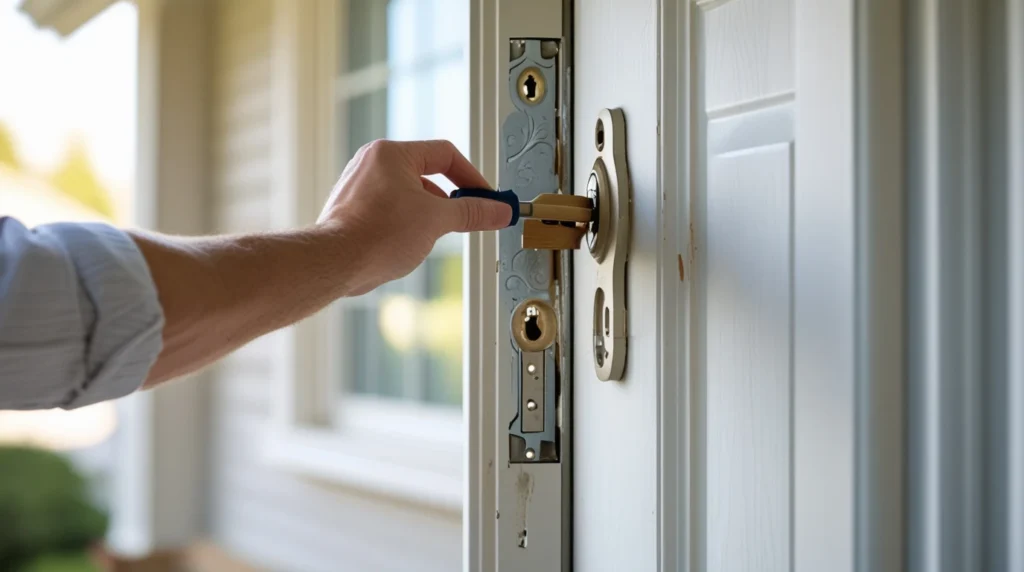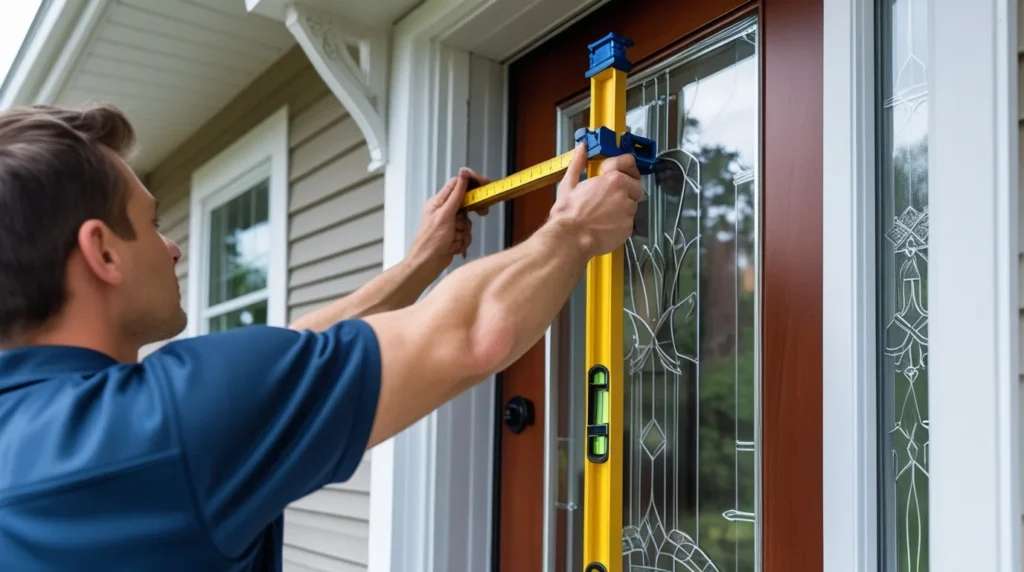If your front door looks worn out but the frame is still solid, you don’t need a full replacement. This guide explains how to replace a front door without replacing the frame, helping you update your entryway quickly and affordably. You’ll learn the exact steps, tools needed, and how to avoid common mistakes so your door fits perfectly and looks great.
Your front door is one of the first things people notice about your home. It gives visitors a first impression and keeps your family safe. If your door looks old, doesn’t close well, or lets in cold air, it might be time for an update. Many homeowners wonder how to replace a front door without replacing the frame to save time and money. The good news is, you don’t always have to replace the frame to get a fresh new look. With the right door and a little careful work, you can make a big change without a huge project.
Can You Replace a Front Door Without Replacing the Frame?
Yes, you can! If your existing door frame is still strong, straight, and free from rot, you don’t need to replace it. You can install a new door right into the old frame. This can save a lot of money and effort. The key is checking the frame first. If it’s in good shape, you can easily move forward. Many people ask, “Can you replace a front door without replacing the frame?” The answer is yes, but you need to make sure the frame is not damaged or bent.

Understanding the Basics: What Is an Exterior Door Without a Frame?
An exterior door without a frame is called a slab door. A slab door is just the door by itself, with no hinges or frame attached. When you buy an exterior door without a frame, it’s meant to fit into your existing frame. This is different from a prehung door, which already comes with a new frame attached. Choosing a slab exterior door 36×80 is common for most homes because it’s a standard size. However, always measure carefully because even small differences can cause problems later.
When Should You Install a Door Without a Frame? Signs to Look For
There are a few signs that tell you it’s safe to install a door without replacing the frame:
- The frame is not cracked, rotted, or warped.
- The door you are replacing fits well and swings properly.
- There are no large gaps between the door and the frame.
- The door locks and latches securely without force.
If these things are true, you can replace just the door. If not, you might have to fix or replace the frame, too. Many homes can simply install a door without frame changes if the structure is solid.
How to Replace a Front Door Without Replacing the Frame: Step-by-Step Guide
Ready to learn how to replace a front door without replacing the frame? Here’s a simple step-by-step:
Step 1: Measure Carefully
Measure the old door’s height, width, and thickness. Double-check! Even a tiny mistake can cause problems.
Step 2: Remove the Old Door
Unscrew the hinges and take off the door. Be careful not to damage the frame.
Step 3: Prepare the New Door
If needed, trim the new door to match the old one. Sometimes, small sanding helps it fit better.
Step 4: Mark Hinge and Lock Positions
Place the old door on top of the new one and trace the hinge and lock spots.
Step 5: Attach Hinges
Screw the hinges onto the new door in the right spots.
Step 6: Install the Door
Hang the door in the frame and check if it swings smoothly.
Step 7: Weatherproof and Seal
Use weatherstripping to stop drafts. Caulk around the edges if needed.
When you do it carefully, replacing a front door without replacing the frame can be smooth and cost-effective.

Choosing the Right Door: Slab Exterior Door 36×80 vs. Prehung Doors
Choosing between a slab door and a prehung door depends on your project.
If your frame is fine, a slab exterior door 36×80 is a smart, affordable choice.
If your frame is broken or old, a prehung door makes more sense.
A slab door gives more flexibility in looks and styles. It’s also lighter and easier for DIY projects. But you need to make sure the measurements are perfect.
How to Install an Exterior Door Without a Frame: Simple Installation Tips
When you need to know how to install an exterior door without a frame, here are quick tips:
Dry Fit First:
Put the door in the opening before attaching anything.
Use Shims:
Shims help adjust small gaps so the door fits tightly.
Secure Hinges Well:
Use strong screws long enough to reach the wall studs.
Check the Swing:
Make sure the door swings freely and closes firmly.
Seal It:
Add weather-stripping and a door sweep to block air leaks.
Taking time to follow these tips will help make your new door last longer and work better.
Hanging a Door in an Existing Frame Without Errors
How to hang a door in an existing frame without mistakes is all about patience and preparation.
Match the old door:
Use it as a guide for hinge spots and handle holes.
Sand if necessary:
Sometimes, small sanding fixes tight spots.
Double-check everything:
Always test before drilling permanent holes.
Use strong hinges:
Old hinges may be worn out, so consider upgrading.
Keep it level:
Always use a level tool to avoid a crooked door.
If you work carefully, you can install a new door without any frame changes and have it look perfect.

Replacing a Front Door vs. Replacing a Door Frame Exterior: What’s the Difference?
Many people get confused between replacing a front door and replacing a door frame exterior. Here’s the difference:
- Replacing the front door means keeping the frame and just installing a new door slab.
- Replacing the door frame exterior means removing the old frame and installing a new one, which usually needs a prehung door.
If your frame is rotted, crooked, or cracked, it’s better to replace the frame too. But if your frame is solid, you can easily replace the exterior door only, saving money and time.
Common Challenges When You Replace the Exterior Door Only
When you replace an exterior door but not the frame, some common problems may come up:
Size mismatch:
Even a 1/8-inch difference can cause fitting problems.
Old frames are not square:
Over time, homes settle, and frames might shift slightly.
Hinge alignment issues:
If your new door and old frame don’t line up perfectly, you might need to adjust the hinge spots.
Weatherproofing mistakes:
Forgetting to seal the edges can lead to drafts and water leaks.
Knowing these challenges ahead of time can help you plan better and avoid headaches.

Professional Help in Spokane, WA: Trust Five Window Install Spokane for Door Replacements
While learning how to install a door without a frame is a great DIY project, sometimes it’s best to call in the pros. If you want your project done quickly and correctly, hiring local experts is a smart choice. Five Window Install Spokane specializes in front door and exterior door installations for homes in Spokane, WA. Their experienced team knows exactly how to measure, fit, and weatherproof your new door to last for years to come. Trust their local expertise to make your front entryway look beautiful and secure.
Conclusion
Replacing a front door without replacing the frame is a smart way to update your home’s look, boost security, and improve energy efficiency without the extra costs. If your frame is strong and in good shape, you can install a new door yourself or with a little professional help. Just remember to measure carefully, fit the door properly, and seal everything to protect against the weather. Whether you choose a slab exterior door 36×80 or another option, understanding how to replace a front door without replacing the frame gives you more control over your home’s updates. By taking your time and doing it right, you can create a beautiful entryway that you and your family will enjoy for years to come.
If you want expert help to replace your front door quickly and perfectly, contact Five Window Install Spokane. Their team is ready to bring your vision to life with the care and skill your home deserves!






